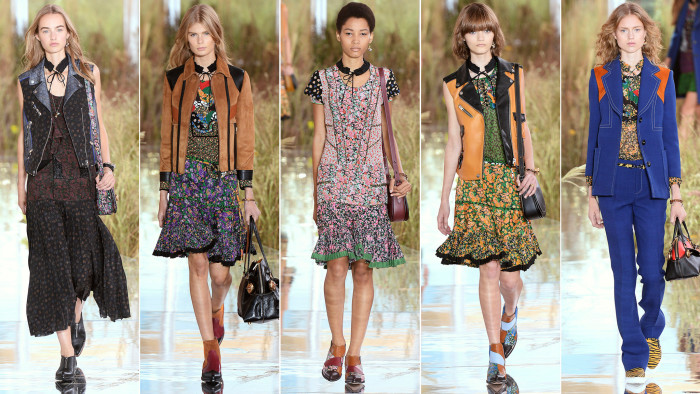New York: Coach SS16 show report

Simply sign up to the Life & Arts myFT Digest -- delivered directly to your inbox.
Magicking up a clothing line from an accessories label is not easy. Since being made executive creative director of Coach in June 2013, Stuart Vevers has been tentative about presenting his new proposition at the accessories house: until now he has only staged quiet presentations of his infant ready-to-wear.
For his fourth season, however, Vevers presented his first runway collection for the house — which will mark its 75th anniversary next year — with a collection of prairie-swept Americana. Staged in a glass box on the High Line, one of the city’s rare spots of greenery and just in front of the space where Coach will make its new headquarters, the collection was Vevers’ boldest statement yet about his creative vision for the company. The collection was a carefree eulogy to the open roads of the South West and sunset-filtered nostalgia.
Coach needs this to work. In its fourth fiscal quarter reported at the end of June, annual sales were down 8 per cent, with sales in North America down 20 per cent to $2.47bn. The brand is currently opening new stores apace in Asia, and many fashion editors were bumped from their seats to accommodate the large number of Chinese landlords who had been flown in to see the collection and get a good look at their new tenants. This collection was all about establishing Vevers’ point of view and finding a new identity within the tricky accessible luxury market.
But what is Coach? Vevers has already established many core components of his branding — a new logo, hardware detail, a magpie-like affection for cutesy gewgaws — but at its essence, he told me at a preview days before, “it’s about a burnished, tan, American leather”. It really is: according to Vevers, Coach is the second-biggest buyer of cow hide in the world — after General Motors. True or not, it gives one a sense of the brand’s productive scale.
Here, though, Vevers had limited its use. There were biker and mod vests in multicolour; there were suede details on a Western-style blazer in cherry hopsack, and a delicious saddle-coloured car coat. He used leather as a patchwork of colours on bandit Chelsea boots, and appliquéd it on to bags, which had been radically stripped of hardware and decorated instead with brightly coloured leather blooms.
But it was the dresses — part prairie, part grunge — that stole the show. Vevers had developed vintage-looking floral prints and then “punked the colours up”, using clashing panels to create pretty meadow dresses with spriggy skirts, detachable collars, and a flippy trim.
Everyone is talking about “ease and lightness” at these shows. Stiff, starched shapes are out, and the silhouette is loose and languid. These dresses recalled the same playful charm of early Anna Sui, or indeed Luella, the former British design house with whom Vevers worked for eight years as accessories designer. They were charming.
With Marc by Marc Jacobs now incorporated in the Marc Jacobs line, and its renewed emphasis on luxurious maturity, there may be a gap in the market for an American house with a flirty, fun, playful aesthetic. It will be interesting to see whether the boy from Carlisle can market this very American dream.
For more reports from the New York shows, go to our fashion weeks page on the FT web app, or visit our New York Collections Women SS16 fashion weeks hub on FT.com
Photographs: Catwalking.com
Comments